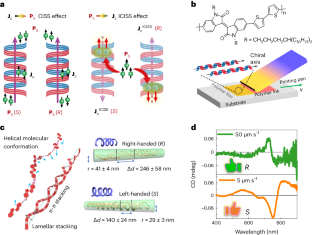2024-03-15 ノースカロライナ州立大学(NCState)
<関連情報>
- https://news.ncsu.edu/2024/03/printed-polymer-allows-researchers-to-explore-chirality-and-spin-interactions-at-room-temperature/
- https://www.nature.com/articles/s41563-024-01838-8
π共役系高分子のキラル集合体における逆キラリティ誘起スピン選択効果 Inverse chirality-induced spin selectivity effect in chiral assemblies of π-conjugated polymers
Rui Sun,Kyung Sun Park,Andrew H. Comstock,Aeron McConnell,Yen-Chi Chen,Peng Zhang,David Beratan,Wei You,Axel Hoffmann,Zhi-Gang Yu,Ying Diao & Dali Sun
Nature Materials Published:15 March 2024
DOI:https://doi.org/10.1038/s41563-024-01838-8

Abstract
Coupling of spin and charge currents to structural chirality in non-magnetic materials, known as chirality-induced spin selectivity, is promising for application in spintronic devices at room temperature. Although the chirality-induced spin selectivity effect has been identified in various chiral materials, its Onsager reciprocal process, the inverse chirality-induced spin selectivity effect, remains unexplored. Here we report the observation of the inverse chirality-induced spin selectivity effect in chiral assemblies of π-conjugated polymers. Using spin-pumping techniques, the inverse chirality-induced spin selectivity effect enables quantification of the magnitude of the longitudinal spin-to-charge conversion driven by chirality-induced spin selectivity in different chiral polymers. By widely tuning conductivities and supramolecular chiral structures via a printing method, we found a very long spin relaxation time of up to several nanoseconds parallel to the chiral axis. Our demonstration of the inverse chirality-induced spin selectivity effect suggests possibilities for elucidating the puzzling interplay between spin and chirality, and opens a route for spintronic applications using printable chiral assemblies.



